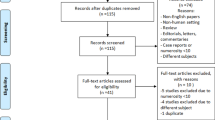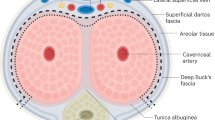Abstract
Staged reconstruction repair of bladder exstrophy results in hydronephrosis or renal scarring in 15–25% of patients. A cosmetically acceptable and functional phallus can be achieved in 85% of patients, 20–30% of whom will require more than one operation for penile reconstruction. Episodes of penile glans loss or corporal loss are rarely reported with this technique. Widely disparate results relating to complete urinary continence and volitional voiding have been published, with urinary continence reported to occur in 7–85% of patients. The need for bladder augmentation to obtain urinary continence also varies, with reports that somewhere between 10% and 90% of patients require an augmentation procedure to gain urinary continence. Complete primary repair of bladder exstrophy using the penile disassembly technique results in hydronephrosis or renal scarring in 0–30% of patients, and hypospadias, as a consequence of this repair, will occur in 30–70% of patients. Loss of the glans and corpora appear more frequently with penile disassembly than in staged reconstruction of bladder exstrophy, however, the exact incidence of this complication is unknown. Reported complete urinary continence and volitional voiding rates are also varied following penile disassembly, ranging from 25–65%. A modified bladder-neck reconstruction to gain urinary continence is reportedly required in 15–90% of patients, with 5–10% requiring both bladder augmentation and bladder-neck reconstruction. Experience with complete primary repair of bladder exstrophy, using the penile disassembly approach, seems promising but is not a panacea. To outline the risks and benefits regarding the various surgical techniques for bladder exstrophy, we would recommend the establishment of a national registry for patients with this disorder.
Key Points
-
The aims of reconstructive surgery in patients with bladder exstrophy are to maintain kidney function, achieve urinary continence and to create or preserve functionally normal external genitalia
-
As repair of bladder exstrophy is conducted at a young age, complications associated with surgery might take many years to become evident
-
Although favorable results in terms of renal function and cosmetic appearance have been achieved with staged reconstruction, persistent urinary incontinence is a common complication, and as a result this procedure has become less popular
-
For complete primary repair to be most effective, it is best conducted as soon as possible following birth
-
Complete primary repair offers preservation of renal function and the promise of continence in many patients; however, hypospadias and ischemic changes to the penis can arise
-
Outcomes of both staged reconstruction and complete primary repair are variable, and a national database should be established in order to collect information on success rates and complications associated with repair of bladder exstrophy
This is a preview of subscription content, access via your institution
Access options
Subscribe to this journal
Receive 12 print issues and online access
$209.00 per year
only $17.42 per issue
Buy this article
- Purchase on Springer Link
- Instant access to full article PDF
Prices may be subject to local taxes which are calculated during checkout
Similar content being viewed by others
References
Husmann D and Spence H (1991) Ureterosigmoidostomy, current concepts. In Bladder Reconstruction and Continent Urinary Diversion, 213–220 (Eds King L et al.) Chicago: Yearbook Medical Publishers
Husmann D et al. (1999) Urinary continence after staged bladder reconstruction for cloacal exstrophy: the effect of coexisting neurological abnormalities on urinary continence. J Urol 161: 1598–1602
Husmann D et al. (1990) Factors predisposing to renal scarring: following staged reconstruction of classical bladder exstrophy. J Ped Surg 25: 500–504
Husmann D et al. (1988) A comparison of renal function in the exstrophy patient treated with staged reconstruction versus urinary diversion. J Urol 140: 1204–1206
Bolduc S et al. (2002) The fate of the upper urinary tract in exstrophy. J Urol 168: 2579–2582
Mourtzinos A and Borer J (2004) Current management of bladder exstrophy. Curr Urol Rep 5: 137–141
Rudin L et al. (1972) Histologic analysis of the exstrophied bladder after anatomical closure. J Urol 108: 802–807
Mathews R et al. (2004) Ultrastructure of the bladder in classic exstrophy: correlation with development of continence. J Urol 172: 1446–1449
Mitchell M (2005) Bladder exstrophy repair: complete primary repair of bladder exstrophy. Urology 65: 5–8
Hollowell J et al. (1991) Bladder function and dysfunction in exstrophy and epispadias. Lancet 338: 926–931
Dave S et al. (2001) Cystometric evaluation of reconstructed classical bladder exstrophy. BJU Int 88: 403–406
Hollowell J and Ransley P (1991) Surgical management of incontinence in bladder exstrophy. Br J Urol 68: 543–546
Silver R et al. (1997) Penile length in adulthood after exstrophy reconstruction. J Urol 158: 999–1003
Meyer K et al. (2004) The exstrophy-epispadias complex: is aesthetic appearance important? BJU Int 93: 1062–1068
Kelley J and Eraklis A (1971) A procedure for lengthening the phallus in boys with exstrophy. J Ped Surg 6: 645–649
Husmann D and Gearhart J (2004) Loss of the penile glans and/or corpora following primary repair of bladder exstrophy using the complete penile disassembly technique. J Urol 172: 1696–1700
Williams D and Savage J (1966) Reconstruction of the exstrophied bladder. Br J Urol 53: 168–173
Lattimer J and Smith M (1966) Exstrophy closure: a follow-up of 70 cases. J Urol 95: 356–359
Ansell J (1979) Surgical treatment of exstrophy of the bladder with emphasis on neonatal primary closure: personal experience with 28 consecutive cases treated at the University of Washington Hospitals from 1962 to 1977. Techniques and results. J Urol 121: 650–653
Cukier J and Ott R (1971) Disappointing results of reconstruction in the treatment of bladder exstrophy [French]. Ann Chir Infant 12: 382–385
Martinez-Pineiro J (1976) Long-term results of surgical treatment of bladder exstrophy. Eur Urol 2: 168–174
Cendron J (1971) Bladder reconstruction. Method derived from that of Trendelenbourg [French]. Ann Chir Infant 12: 371–381
Jeffs R et al. (1972) Primary closure of the exstrophied bladder. In Current Controversies in Urologic Management, 235–243 (Ed Scott JR) Philadelphia: WB Saunders
Gearhart J and Jeffs R (1989) Bladder exstrophy: increase in capacity following epispadias repair. J Urol 142: 525–529
Matthews R and Gearhart J (2005) Modern staged reconstruction of bladder exstrophy—still the gold standard. Urology 65: 2–4
Woodhouse C (1998) Sexual function in boys born with exstrophy, myelomeningocele, and micropenis. Urology 52: 3–11
Mesrobian H et al. (1986) Long-term follow-up of cosmetic and genital function in boys with exstrophy: review of 53 patients. J Urol 136: 256–258
Gearhart J (2001) Complete repair of bladder exstrophy in the newborn: complications and management. J Urol 165: 2431–2434
Amukele S et al. (2003) 20-year experience with iatrogenic penile injury. J Urol 170: 1691–1694
Diamond D et al. (1999) Normal urodynamics in patients with bladder exstrophy: are they achievable? J Urol 162: 841–844
Mollard P et al. (1994) Urinary continence after reconstruction of classical bladder exstrophy. Br J Urol 73: 298–301
McMahon D et al. (1996) Vesical neck reconstruction in patients with the exstrophy-epispadias complex. J Urol 155: 1411–1414
Mouriquand P et al. (2003) Long-term results of bladder neck reconstruction for incontinence in children with classical bladder exstrophy or incontinent epispadias. BJU Int 92: 997–1001
Chan D et al. (2001) Determinants of continence in the bladder exstrophy population: predictors of success? Urology 57: 774–777
Surer I et al. (2001) Modified Young–Dees–Leadbetter bladder neck reconstruction in patients with successful primary bladder closure elsewhere: a single institution experience. J Urol 165: 2438–2440
Husmann D et al. (1989) Closure of the exstrophic bladder: an evaluation of the factors leading to its success and its importance on urinary continence. J Urol 142: 522–524
Canning D (1996) Bladder exstrophy: the case for primary bladder reconstruction. Urology 48: 831–835
Lottman H et al. (1997) Bladder exstrophy: evaluation of factors leading to continence with spontaneous voiding after staged reconstruction. J Urol 158: 1041–1045
Capolicchio G et al. (2001) A population based analysis of continence outcomes and bladder exstrophy. J Urol 165: 2418–2421
Shaw M et al. (2004) Continence and classic bladder exstrophy treated with staged repair. J Urol 172: 1450–1453
Mitchell M and Bägli D (1996) Complete penile disassembly for epispadias repair: the Mitchell technique. J Urol 155: 300–303
Grady R and Mitchell M (1998) Newborn exstrophy closure and epispadias repair. World J Urol 26: 200–204
Grady R and Mitchell M (1999) Complete primary repair of exstrophy. J Urol 162: 1415–1418
El-Sherbiny M et al. (2002) Complete repair of exstrophy: further experience with neonates and children after failed exstrophy closure. J Urol 168: 1692–1694
Hammouda HM and Kotb H (2004) Complete primary repair of bladder exstrophy: initial experience with 33 cases. J Urol 172: 1441–1444
Caione P et al. (2000) Periurethral muscle complex reassembly for exstrophy–epispadias repair. J Urol 164: 2062–2066
Hafez A and El-Sherbiny M (2005) Complete repair of bladder exstrophy: management of resultant hypospadias. J Urol 173: 958–961
Perovic S et al. (1999) Penile disassembly technique for epispadias: variants of technique. J Urol 162: 1181–1183
Emir L et al. (2002) A novel solution for the short neourethra in Mitchell epispadias repair. J Urol 167: 2168–2170
Hammouda HM (2003) Results of complete penile disassembly for epispadias repair in 42 patients. J Urol 170: 1963–1965
Author information
Authors and Affiliations
Corresponding author
Ethics declarations
Competing interests
The author declares no competing financial interests.
Rights and permissions
About this article
Cite this article
Husmann, D. Surgery Insight: advantages and pitfalls of surgical techniques for the correction of bladder exstrophy. Nat Rev Urol 3, 95–100 (2006). https://doi.org/10.1038/ncpuro0407
Received:
Accepted:
Issue Date:
DOI: https://doi.org/10.1038/ncpuro0407
This article is cited by
-
Exstrophy-epispadias complex: are the kidneys and kidney function spared?
Pediatric Nephrology (2023)
-
Bladder exstrophy: current management and postoperative imaging
Pediatric Radiology (2014)



